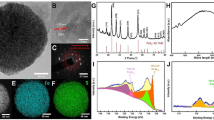Abstract
Photothermal therapy (PTT) has attracted great attention in cancer therapy because of high efficiency and low side effect. The semiconductors have been proved to be ideal photothermal agents in the past years. Herein, we synthesized a novel hexahedron structure of polyvinyl pyrrolidone (PVP) coating CuS nanocrystals (NCs) by a facile hydrothermal method. The synthesized CuS NCs (150 nm for average length of edge and 125 nm for length of width) have good biocompatibility due to their PVP coating and strong absorption in the near infrared region. Moreover, the CuS NCs exhibit high photothermal conversion efficiency as well as good antibacterial effect. Notably, the proliferation of osteosarcoma cancer cells can be efficiently inhibited both in vitro and in vivo by the fatal heat with very low concentration of CuS NCs under the near infrared ray at a power density of 0.5 W/cm2. Therefore, the CuS-PVP NCs have great potential to work as an ideal photothermal and antibacterial agent in clinical applications.








Similar content being viewed by others
References
Ali MRK, Ali HR, Rankin CR, El-Sayed MA (2016) Targeting heat shock protein 70 using gold nanorods enhances cancer cell apoptosis in low dose plasmonic photothermal therapy. Biomaterials 102:1
Austin LA, Mackey MA, Dreaden EC, El-Sayed MA (2014) The optical, photothermal, and facile surface chemical properties of gold and silver nanoparticles in biodiagnostics, therapy, and drug delivery. Arch Toxicol 88:1391–1417
Biswas B (2016) Facile syntheses of copper sulfide nanoparticles: antibacterial and antifungal activity study. Rasayan J Chem 09:77–83
DeSantis CE, Lin CC, Mariotto AB, Siegel RL, Stein KD, Kramer JL, Rowland JH, Stein KD, Alteri R, Jemal A (2014) Cancer treatment and survivorship statistics, 2014. CA-Cancer J Clin 64:252–271
Hessel CM, Pattani VP, Rasch M, Panthani MG, Koo B, Tunnell JW, Korgel BA (2011) Copper selenide nanocrystals for photothermal therapy. Nano Lett 11:2560–2566
Huang X, Jain PK, El-Sayed IH, El-Sayed MA (2008) Plasmonic photothermal therapy (PPTT) using gold nanoparticles. Lasers Med Sci 23:217–228
Jaque D, Martinez Maestro L, del Rosal B, Haro-Gonzalez P, Benayas A, Plaza JL, Martín RE, García SJ (2014) Nanoparticles for photothermal therapies. Nano 6:9494–9530
Kuo W-S, Chang C-N, Chang Y-T, Yang M-H, Chien Y-H, Chen S-J, Yeh CS (2010) Gold nanorods in photodynamic therapy, as hyperthermia agents, and in near-infrared optical imaging. Angew Chem 122:2771–2775
Li DJ, Nie W, Chen L, Miao YK, Zhang X, Chen FC, Yu B, Ao RG, Yu BQ, He CL (2017) Fabrication of curcumin-loaded mesoporous silica incorporated polyvinyl pyrrolidone nanofibers for rapid hemostasis and antibacterial treatment. RSC Adv 7:7973–7982
Li LH, Li M, Li D, He P, Xia H, Zhang Y, Mao C (2014) Chemical functionalization of bone implants with nanoparticle-stabilized chitosan and methotrexate for inhibiting both osteoclastoma formation and bacterial infection. J Mater Chem B 2:5952–5961
Li Y, Lu W, Huang Q, Huang M, Li C, Chen W (2010) Copper sulfide nanoparticles for photothermal ablation of tumor cells. Nanomedicine 5:1161–1171
Liu X, Li B, Fu F, Xu K, Zou R, Wang Q, Zhang B, Chen Z, Hu J (2014) Facile synthesis of biocompatible cysteine-coated CuS nanoparticles with high photothermal conversion efficiency for cancer therapy. Dalton T 43:11709–11715
Ning C, Wang X, Li L, Zhu Y, Li M, Yu P, Zhou L, Zhou Z, Chen J, Tan G, Zhang Y, Wang Y, Mao C (2015) Concentration ranges of antibacterial cations for showing the highest antibacterial efficacy but the least cytotoxicity against mammalian cells: implications for a new antibacterial mechanism. Chem Res Toxicol 28:1815–1822
Qian C, Xu L, Chao L, Chao W, Rui P, Zhuang L (2016) Photothermal therapy with immune-adjuvant nanoparticles together with checkpoint blockade for effective cancer immunotherapy. Nat Commun 7:13193
Park H, Yang J, Seo S, Kim K, Suh J, Kim D, Haam S, Yoo KH (2008) Multifunctional nanoparticles for photothermally controlled drug delivery and magnetic resonance imaging enhancement. Small 4:192–196
Schroeder A, Heller DA, Winslow MM, Dahlman JE, Pratt GW, Langer R, Jacks T, Anderson DG (2012) Treating metastatic cancer with nanotechnology. Nat Rev Cancer 12:39–50
Shenoi MM, Shah NB, Griffin RJ, Vercellotti GM, Bischof JC (2011) Nanoparticle preconditioning for enhanced thermal therapies in cancer. Nanomedicine 6:545–563
Tian Q, Tang M, Sun Y, Zou R, Chen Z, Zhu M, Yang S, Wang J, Wang J, Hu J (2011b) Hydrophilic flower-like CuS superstructures as an efficient 980 nm laser-driven photothermal agent for ablation of cancer cells. Adv Mater 23:3542–3547
Tian Q, Jiang F, Zou R, Liu Q, Chen Z, Zhu M, Yang S, Wang J, Wang J, Hu J (2011a) Hydrophilic Cu9S5 nanocrystals: a photothermal agent with a 25.7% heat conversion efficiency for photothermal ablation of cancer cells in vivo. ACS Nano 5:9761–9771
Xiali Z, Zhang Y, Huang H, Zhang H, Hou L, Zhang Z (2016) Folic acid-modified and functionalized cus nanocrystal-based nanoparticles for combined tumor chemo- and photothermal therapy. J Drug Target 25(5):1
Yan L, Qiu L (2015) Indocyanine green targeted micelles with improved stability for near-infrared image-guided photothermal tumor therapy. Nanomedicine 10:361–373
Zhao Y, Song W, Wang D, Ran H, Wang R, Yao Y, Wang Z, Zheng Y, Li P (2015) Phase-shifted PFH@PLGA/Fe3O4 nanocapsules for MRI/US imaging and photothermal therapy with near-infrared irradiation. ACS Appl Mater Inter 7:14231–14242
Author information
Authors and Affiliations
Corresponding author
Ethics declarations
Funding Information
We appreciate the financial support from the National Key Research Program of China (Grant No. 2017YFB0702604 and 2016YFB0700803), National Natural Science Foundation of China (Grant Nos. 81501859 and 81601884), Natural Science Foundation of Guangdong Province, China (Grant No. 2015A030312004), and Scientific and Technological Projects of Guangzhou, China (Grant No. 201604020110).
Conflict of interest
The authors declare that they have no conflict of interest.
Rights and permissions
About this article
Cite this article
Hu, X., Li, L., Lu, Y. et al. Multifunctional CuS nanocrystals for inhibiting both osteosarcoma proliferation and bacterial infection by photothermal therapy. J Nanopart Res 19, 295 (2017). https://doi.org/10.1007/s11051-017-3992-6
Received:
Accepted:
Published:
DOI: https://doi.org/10.1007/s11051-017-3992-6




